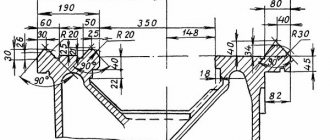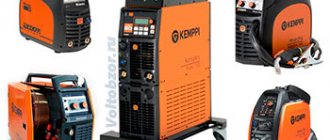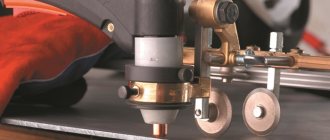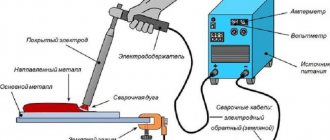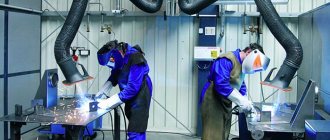Welding is one of the most significant inventions of mankind. After all, with its advent, people have the opportunity to create previously inaccessible products using monolithic metal compounds. Welding helped make a serious breakthrough in the manufacturing sector, the results of which humanity has continued to benefit from for decades.
At first, only electric welding , but as it improved, a more universal one, gas welding , appeared, which differed from electric welding in its wider scope of application. A special feature of gas welding is that in order to join metals, their surfaces are exposed to high temperatures resulting from the combustion of flammable gases in oxygen.
To carry out welding, it is necessary to create a special working environment, for which a special energy carrier is used - bottled gas or an acetylene generator . The welding itself is carried out using a torch or cutter . The final choice depends on the type of operations being performed. The main advantage of gas welding is the ability to join non-ferrous metals to create a neat and beautiful seam.
For welding, a single gas or a special mixture can be used, including butane, propane, argon, oxygen and other types of gases. But most often, welding is carried out using a mixture of acetylene with oxygen and oxygen with propane and butane, since today these are the most accessible types of gases, and the melt zone created with their help has the highest characteristics.
Equipment for gas welding work
To be able to carry out gas welding, you must ensure that you have the following units:
- An acetylene generator or a cylinder with another flammable gas. In domestic conditions, mobile acetylene generators are most often used, in which gas is produced as a result of the reaction of water with calcium carbide. But sometimes it is replaced with ready-made gas, which is most often used propane or butane. For greater convenience, it is desirable that the cylinders be equipped with flow meters.
- Oxygen cylinder.
- Safety valves for cylinders. They are safety devices that help prevent fire when the flame returns from the burner.
- Reducer for oxygen and working gas cylinders. They help regulate pressure.
- Supply hoses , also called hoses. Each group of gases has its own type of hose. There are three categories in total. In accordance with safety requirements, the hose must not be connected to a gas cylinder for which it is not intended.
- Burner . Today, gas burners almost always come with attachments that can be used to change the required flame parameters.
- Welding table . It represents the working area in which the welding process takes place. For safety reasons, the welding table must be equipped with a metal or brick plate.
Generally speaking, the entire set of equipment for gas welding is usually called a welding station . To avoid many difficulties, a special flat wheeled trolley with a frame is used to transport welding equipment, where the gas welding and cutting apparatus and cylinders are mounted in a vertical position using clamps, and the hoses are also arranged in a twisted form.
Such a post is highly mobile and can be delivered to the work site with minimal time. Such a need may arise when you need to weld on a fixed structure that cannot be brought closer to a gas welding machine.
Areas of use
The availability and relative cheapness of installation work using gas welding machines have also determined the scope of their use in practical human activity. Gas welding methods are widely used in the following situations:
- when carrying out most types of construction and installation work;
- in public utilities (for repair and replacement of gas, heat and water mains);
- in metallurgy, automobile and shipbuilding, as well as when carrying out high-altitude work on objects under construction of any complexity;
- in private farms (with appropriate equipment and professional skills).
At home, this type of welding of parts is not used so often, however, if you have the appropriate permission from the fire services, it is quite acceptable.
With the help of gas welding and the use of appropriate devices, it is possible to join almost all types of alloys, including non-ferrous metals (with a workpiece thickness of up to 80 millimeters). In the case of thinner parts, this method is also suitable for working with low-carbon and non-alloy steels.
Additional tools and materials
But the above equipment alone is not enough to carry out gas welding work. In addition to the gas welding machine, it is necessary to prepare additional tools:
- Retainers . Necessary to facilitate gas welding work and improve the quality of the joint created. If the part is securely fixed in a static position, then working with it is much easier.
- Lift . When it becomes necessary to connect bulky parts that are difficult to transfer to the table manually.
- Installation tool. Includes a set of wrenches or wrenches used to securely secure key elements of the welding station.
- Related tool . This list should include hacksaws, sledgehammers, pliers, hammers and other devices.
- Hood . Welding, which involves joining metals using gas, necessarily requires effective ventilation.
One of the principles of gas welding technology is the use of filler wire, which fills the weld pool. The wire for welding must be selected taking into account the composition of the surfaces that need to be welded. It must have a uniform and smooth structure. In addition, fluxes are used when welding with gas. We are talking about special compositions, produced in the form of a paste or powder, which are applied to the additive and edges to protect the melt from oxides.
Wire and flux for welding
To weld metals, in addition to gas, you also need wire and flux. It is due to these materials that the welding seam is created and all its characteristics are formed. The wire used for welding must be clean, without signs of corrosion and paint on its surface. In some cases, a strip of the same metal that is being welded can be used as such wire. In order to protect the weld pool from external factors, it is necessary to use a special flux. Boric acid and borax are often used as such flux, which are applied directly to the surface of the metal being welded or to the wire used for welding. Gas welding of carbon steel can be performed without flux, and when joining parts made of aluminum, copper, magnesium and their alloys, such protection is necessary.
Popular models
Today there is a wide selection of welding equipment on sale. There are many manufacturers on the market whose range includes equipment designed for portable and stationary welding. Quite a lot of offers can be found from Chinese manufacturers, however, it is best to opt for products from Russian or European companies:
- Ideal (Germany).
- Steiger (Germany).
- Graphopress (Netherlands).
- kz (Russia).
- Dioxide (Russia).
Acetylene generators
Welding generators produce acetylene, which is obtained by combining calcium carbide with water. Such devices are mobile and stationary. Based on output pressure, they are divided into 3 categories:
low pressure generators up to 0.1 atmosphere;- average from 0.7 to 1.5 atm.;
- high pressure over 1.5 atmospheres.
In this case, the devices can produce from 0.3 m3 to 160 m3 of acetylene per hour.
Based on the method of producing gas, generators are divided into five types:
"KV". In these generators, carbide enters the water in small portions. When the pressure drops below the threshold, a new portion of carbide arrives. The slaked calcium carbide is removed through the bottom outlet valve. Due to its large dimensions it is used in stationary installations. Has the highest yield of acetylene.
"VC". Here the water hits the carbide. Water is supplied in small portions as the pressure decreases. This method is called “wet VC”. The device has a simple and reliable design. Capacity up to 10 m3. The disadvantage is incomplete quenching of calcium carbide.
"VK" for dry process. Water is supplied into the chamber with calcium carbide in doses. When acetylene is formed, heat is released, which evaporates excess water. Due to this, the hydrated carbide turns out dry. Hence the name.
"BB". In generators of this type, gas is produced by displacing water from the gas generation chamber with a basket of calcium carbide. When the pressure drops, the displaced water flows back into the chamber. The device is used in mobile welding stations.
"PC". The generators use a combined principle of gas production. Two methods are combined: “water on carbide” and “water displacement”. Used in mobile installations. Has smooth adjustment of gas supply.
Criterias of choice
- The basic principle on which it is recommended to select gas welding equipment is the type of work planned. Depending on whether cutting or joining is planned, the choice of the most affordable gas is made. In most cases, acetylene is used for gas welding.
- And also when choosing gas welding equipment, it is necessary to take into account the thickness of the metal. Acetylene is recommended to be used when it is necessary to weld parts made of low-carbon and alloy steels with a thickness of no more than 20 mm. To cut thick-walled metal up to 400 mm, you need propane, which is used with a standard pressure mode. If the products being welded have a thickness of about 400-800 mm, then in this case increased oxygen purging will be required, and this can lead to an increase in pressure in the gas pipeline.
- Another important selection criterion is the technical capabilities of the gas burner or cutter used.
How to choose gas depending on the type of metal
The correct choice of the required gas is mainly influenced by the thickness of the sheet of metal with which to work. This choice can be easily made by referring to the appropriate tables. They are compiled on the basis of calculations and taking into account the experience of using gases in various conditions. For example, to weld carbon steel sheets, it is advisable to use a mixture of argon and carbon dioxide followed by the addition of oxygen.
Do you have experience with gas welding? Be sure to share it in the comments to this article!
Equipment Specifications
Gas cylinders
Welding, which is carried out using portable equipment, involves the use of gases stored in special hermetically sealed vessels - cylinders. Each gas must be stored in a container suitable for it, which must have a special shape, dimensions and valve.
- Oxygen cylinders. For their production, alloy or carbon steels are used. Sometimes oxygen cylinders are made from seamless pipes, but they can only store gas for which the permissible pressure is no more than 30 kgf/cm². If it is necessary to maintain a lower pressure in the cylinder, then it should be made only of welded structures. In the latter case, it is recommended to use types 150 and 150JL with a maximum volume of 40 l. Moreover, it is important that during the manufacture of structures the requirements of GOST 949–73 are met.
- Acetylene cylinders. During their production, the requirements of GOST 5948–60 must be met. Most often, in order to ensure maximum safety, such containers are made in the form of two-chamber cylinders, which make it possible to more effectively equalize the pressure inside them. But at the same time, it is important to comply with the main condition - the internal pressure in the acetylene cylinder should not exceed 19 kgf/cm² at 20ºC.
- Cylinders for propane-butane mixture. Their production must be carried out in accordance with the requirements of GOST 15860–70. Such cylinders are made in volumes of 40 and 50 liters. The internal pressure in them should not exceed 16 kgf/m², and they should weigh no more than 24 kg.
Particular care must be taken when handling gas cylinders, as they belong to a high explosion hazard category. As a result, during their use, particularly stringent requirements for their operation must be observed. To be able to transport or carry them, a specialist must undergo special training and obtain a permit.
Cutters
In order to be able to change the pressure of flammable gas on welding equipment, each cylinder must be equipped with a reducer. When choosing a gearbox, first of all you need to pay attention to its throughput. It should be selected based on the type of work being done and the cutters used. Gearboxes come in two types, depending on the design: single-stage and two-stage. The latter are more accurate.
When the gases from the cylinder reach the cutter, they mix. The main part of the cutter is most often made of carbon steel and is equipped with various functional elements - shut-off valves, injectors, a mouthpiece, which are repairable. The cutter itself is necessary to control the welding process and mixing gases.
Cutters may differ from each other in power, which implies their throughput. Based on this, we can conclude that for each cutter it is necessary to select the appropriate burner, which must be of a certain type and size. All cutters have removable parts, so they are universal and can be used for welding with any type of gas.
How gas welding is performed in semi-automatic mode
Semi-automatic gas welding technology requires the use of an electric arc and shielding gas, which makes this method of joining metals a hybrid.
This technology, if we look at it in more detail, looks like this:
- turning on the device;
- threading the wire through a hole located in the burner;
- setting the required gas pressure using a reducer;
- setting the required wire feed speed;
- setting all other welding parameters (voltage and current);
- positioning the torch at the required angle before starting welding.
For each of the welding parameters performed semi-automatically, there are parameters that are specified by the relevant GOSTs:
- pressure generated by the reducer;
- acetylene generator parameters;
- type of hoses used;
- requirements for gas cylinders;
- type of torches used for welding;
- type of wire used for welding.
General safety rules
When performing welding work, safety rules must be observed. Only serviceable equipment may be used. The work place must be at least 10 m from the source of open fire.
We recommend reading Features of pulse welding
The post must be equipped with individual means for extinguishing fires. If only acetylene is used, then a carbon dioxide fire extinguisher or sand is required.
Water should not be used to extinguish fires caused by this substance. If there is a fire, you need to bend the hose in the area of the gearbox, and then close all the valves.
Description of welding technology
Gas welding technology has some features. There are several options for carrying out the work.
Right and left
There are right and left welding patterns. The first option is used most often. It involves moving the burner from the right edge to the left. In this case, the flame jet is directed directly at the wire, which is advanced in front of the burner. This method is often used to weld small parts, thin slabs and materials that melt even at low temperatures.
The second option involves moving the burner from the left edge to the right. In this case, the wire is advanced after the flame. Left-hand welding provides deeper impact and better adhesion.
Multilayer method
This method is used when it is necessary to form a high-strength seam. It involves annealing the lower layer and further surfacing the upper one. Thus, all layers are calcined. This has a positive effect on the quality of the seam.
Through roller
This method requires gradual melting of the upper edge of an existing hole in the workpiece, followed by the application of molten metal to the lower edge of the hole. To carry out the work, it is necessary to fix the metal sheets vertically. Thus, the seam takes the shape of a roller.
Welding pools
This method involves the formation of trays along the seam. A filler wire is introduced into each such formation, which melts and fills the voids. The nozzle moves to a new area, and the next bath overlaps the previously created one.
Oxidizing flame
The method is used to connect elements made of low-carbon steel alloys. The flame in this case oxidizes the material, which leads to the formation of iron oxide. For deoxidation, filler wire is used, including silicon and manganese.

